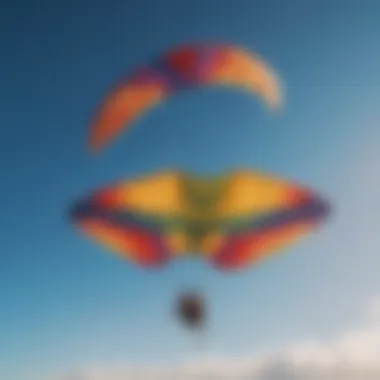Unlocking Kiteboarding Mastery: The Art of Choosing the Right Kite Size


Equipment Reviews
When it comes to optimizing your kiteboarding experience, understanding the nuances of kite sizes is paramount. Kiteboarding enthusiasts know that selecting the right kite size can make a significant difference in performance and safety on the water. It's not just about picking a random size; it's about delving into the intricate details of kite shapes, sizes, materials, and brands to find the perfect match for your riding style and skill level.
Let's start by exploring the latest kite models and their features. Kites come in various shapes and sizes, each designed to cater to different riding conditions and styles. From delta kites to hybrid kites, the choice can be overwhelming for beginners and seasoned riders alike. Understanding the characteristics of each kite shape, such as their aerodynamics and wind range, is crucial in making an informed decision.
Moving on to kite materials, riders often debate between ripstop nylon and polyester fabrics for their kites. While nylon is known for its durability and tear resistance, polyester offers better performance in terms of stability and responsiveness. The choice of material can affect the overall feel and longevity of the kite, making it a key consideration when selecting your ideal kite size.
Brands play a significant role in the kiteboarding industry, with leading manufacturers consistently pushing boundaries in design and innovation. From industry giants to smaller niche brands, each offers unique advantages in terms of quality, craftsmanship, and performance. Riders often swear by their favorite brands, attributing their success on the water to the superior technology and design elements incorporated into these kites.
Travel Destinations
For kitesurfers and extreme athletes seeking new adventures, exploring popular and off-the-beaten-path destinations can elevate the kiteboarding experience to new heights. Whether you're chasing the wind in well-known kitesurfing hotspots or venturing off the tourist trail to discover hidden gems, each destination offers a unique blend of wind conditions, water quality, amenities, and local attractions.
Popular spots like Brazil, Maui, and Tarifa are renowned for their consistent wind patterns, crystal-clear waters, and vibrant kiteboarding communities. These destinations attract riders from across the globe, offering a mix of beginner-friendly lagoons and epic wave-riding opportunities for the more experienced. With amenities ranging from kite schools to beachfront cafes, these spots cater to all levels of riders seeking the ultimate kitesurfing adventure.
Off-the-beaten-path destinations provide a more secluded and intimate kitesurfing experience, away from the crowds and commercialization of mainstream spots. Imagine kiting in remote islands, untouched coastlines, or hidden bays where only the sound of the wind and waves accompanies your ride. These underrated spots offer a glimpse into unspoiled nature, with unique challenges and thrills awaiting those brave enough to venture off the well-trodden kitesurfing routes.
Techniques and Tutorials
Mastering the art of kiteboarding goes beyond selecting the right equipment; it's about honing your skills and techniques on the water. Beginners can benefit from step-by-step tutorials that cover essential aspects of kitesurfing and kiteboarding, from launching and riding to turning and landing with control and finesse.
Advanced riders looking to push their limits can delve into more complex maneuvers and tricks, such as jumps, rotations, wave riding, and freestyle techniques. These advanced skills require precise control, timing, and coordination between rider and kite, enhancing the overall thrill and adrenaline rush of kiteboarding. Whether you're aiming to perfect your backrolls or nail that handle pass, continuous practice and guidance are essential in achieving mastery of these high-level maneuvers.
Safety Guidelines
Safety is paramount in kiteboarding, where wind and water conditions can change rapidly, posing risks to riders of all levels. Understanding how weather conditions, such as wind speed, currents, tides, and storm patterns, impact kiteboarding safety is crucial for a smooth and secure session on the water.
Aside from weather awareness, riders must be equipped with knowledge of emergency protocols and safety measures to handle unforeseen mishaps and accidents. From self-rescue techniques to signaling for assistance, being prepared for emergencies can make a significant difference in averting potential dangers and ensuring a safe return to shore.
Regular equipment maintenance is another critical aspect of kiteboarding safety. Conducting routine checks on your gear, including lines, harnesses, and safety systems, helps prevent equipment failures and malfunctions that could compromise your safety on the water. By prioritizing safety guidelines, riders can enjoy the thrill of kiteboarding while minimizing risks and maximizing their overall experience.
Introduction to Kite Sizes
Understanding kite sizes is a fundamental aspect when it comes to optimizing your kiteboarding experience. The choice of kite size can significantly impact your performance and safety on the water, making it a crucial consideration for all kiteboarding enthusiasts, from novices to professionals. By delving into the intricacies of kite sizes, riders can fine-tune their equipment selection to suit their riding style, skill level, and prevailing wind conditions, ultimately enhancing their overall kiteboarding experience.


Why Kite Size Matters?
Factors Influencing Kite Size Selection
When it comes to selecting the appropriate kite size, various factors come into play, such as rider weight, wind speed, riding style, and specific wind conditions. Each of these elements influences the optimal kite size for a particular session. Understanding how these factors interplay can help riders make informed decisions regarding their kite size selection, ensuring they achieve the desired performance outcomes while maintaining safety on the water.
Impact of Kite Size on Performance
The impact of kite size on performance is profound, directly affecting maneuverability, speed, power delivery, and overall control of the kite. Choosing the right kite size can enhance a rider's ability to execute tricks, navigate varying water conditions, and maximize their riding potential. However, selecting an incorrectly sized kite can lead to suboptimal performance, compromised safety, and potential challenges in managing the kite's power effectively.
Relationship Between Kite Size and Wind Conditions
The relationship between kite size and wind conditions is essential to grasp for any kiteboarding enthusiast. Different kite sizes are designed to perform optimally in specific wind ranges, with larger kites suited for lighter winds and smaller kites preferred in stronger winds. Understanding how kite size influences performance in varying wind speeds empowers riders to select the most suitable kite for the prevailing conditions, ensuring an enjoyable and safe kiteboarding session.
Understanding the Kite Size Chart
Decoding Kite Size Specifications
Deciphering kite size specifications involves understanding the numerical values that denote the size of a kite, including the length and wingspan. These specifications provide vital information regarding the kite's dimensions and intended wind range, guiding riders in matching the kite to the prevailing wind conditions. By decoding kite size specifications accurately, riders can make informed decisions regarding which kite size best suits their individual needs and riding preferences.
Interpreting Kite Size Recommendations
Interpreting kite size recommendations entails considering manufacturer guidelines, rider weight, skill level, and wind conditions to determine the most appropriate kite size for a given session. Manufacturers often provide recommendations based on these factors to assist riders in selecting the optimal kite size for their experience level and riding objectives. Following kite size recommendations can enhance performance, safety, and overall enjoyment during kiteboarding sessions.
Incorporating Rider Skill Level in Kite Size Decision
Accounting for rider skill level in kite size decisions is crucial for optimizing the kiteboarding experience. Novice riders may benefit from starting with larger kites that offer stability and forgiveness, while advanced riders might prefer smaller kites for increased agility and responsiveness. By aligning kite size with rider proficiency, individuals can enhance their progression, master new skills, and elevate their overall performance on the water.
Choosing the Right Kite Size
When it comes to kiteboarding, selecting the appropriate kite size is a critical decision that can significantly impact your overall experience on the water. Choosing the right kite size is not just about personal preference; it involves a careful consideration of various factors such as wind conditions, rider skill level, and desired performance outcomes. By understanding the nuances of kite sizes, riders can optimize their performance, ensure safety, and maximize their enjoyment of this exhilarating sport.
Beginner Riders
Ideal Kite Sizes for Novices


For beginners venturing into the world of kiteboarding, selecting the ideal kite size is crucial. Typically, novice riders benefit from using kites that are larger in size as they provide more stability, easier relaunch, and forgiving flying characteristics. Larger kites also offer better low-end power, which is beneficial for beginners as they develop their kite control skills. While larger kites offer stability and ease of use, they may lack the agility and responsiveness found in smaller kites. Beginners should prioritize safety and comfort when choosing their kite size to facilitate a smooth learning curve.
Tips for Safe and Smooth Learning Experience
To ensure a safe and enjoyable learning experience in kiteboarding, beginner riders should follow key tips that enhance their progression and skills. One essential tip is to always undergo proper kiteboarding lessons with certified instructors to learn fundamental techniques and safety protocols. Additionally, beginners should focus on developing strong kite control skills in varying wind conditions to build confidence on the water. Practicing self-rescue techniques and understanding basic weather patterns are also crucial for ensuring a smooth learning journey. By incorporating these tips into their practice, beginner riders can enhance their skills and safety awareness while enjoying the thrill of kiteboarding.
Intermediate to Advanced Riders
Optimizing Performance with Appropriate Kite Sizes
As riders progress from intermediate to advanced levels, optimizing performance through the selection of suitable kite sizes becomes paramount. Advanced riders often gravitate towards smaller kites that offer increased maneuverability, faster turning speeds, and enhanced power delivery. By choosing kite sizes that align with their riding style and preferences, advanced riders can push their limits, perfect intricate maneuvers, and unlock the full potential of their skills. It is essential for advanced riders to experiment with different kite sizes to find the optimal balance between agility and power for their unique riding preferences.
Fine-Tuning Kite Selection Based on Riding Style
Fine-tuning kite selection based on riding style is a strategy employed by many experienced kiteboarders to elevate their performance on the water. Different riding styles, such as freestyle, wave riding, or big air jumps, require specific kite characteristics to maximize efficiency and control. Experienced riders tailor their kite size choices to match their preferred riding style, factoring in variables such as wind speed, wave conditions, and desired tricks or maneuvers. By refining their kite selection based on riding style, advanced riders can achieve greater precision, control, and satisfaction in executing complex kiteboarding moves, ultimately enhancing their overall experience in the sport.
Safety Considerations and Kite Sizes
Safety considerations when it comes to kite sizes play a vital role in ensuring an optimal kiteboarding experience. Understanding the correlation between safety and choosing the right kite size is paramount for all riders, from beginners to advanced enthusiasts. By focusing on safety considerations and kite sizes, individuals can mitigate risks and enjoy the sport to its fullest potential. Factors such as wind strength, rider skill level, and emergency protocols are crucial components to consider when delving into the realm of kiteboarding.
Risk Mitigation Strategies
Matching Kite Size to Wind Strength
Matching kite size to wind strength is a pivotal aspect of kiteboarding safety. Ensuring that the kite size aligns with the current wind conditions is essential for maintaining control and maneuverability on the water. By selecting the appropriate kite size based on wind strength, riders can optimize their performance and minimize the risk of accidents. Understanding how to match kite size to varying wind speeds is key to a safe and enjoyable kiteboarding session.
Addressing Overpowered and Underpowered Situations
Addressing overpowered and underpowered situations is a critical risk mitigation strategy in kiteboarding. Being equipped to handle scenarios where the kite is either too powerful or lacks sufficient power is essential for rider safety. Implementing techniques to manage overpowered and underpowered conditions, such as adjusting kite trim or depower settings, can prevent accidents and ensure a smooth kiteboarding experience. By proactively addressing these situations, riders can navigate challenging wind conditions and maintain control over their kite.
Emergency Protocols
Dealing with Unexpected Wind Changes
Dealing with unexpected wind changes is a fundamental aspect of kiteboarding safety measures. Unpredictable shifts in wind direction or intensity can pose challenges for riders on the water. Knowing how to adapt to sudden wind variations and adjust kite handling techniques is crucial for avoiding accidents and maintaining control. Developing strategies to anticipate and respond to unexpected wind changes enhances rider safety and prevents potential mishaps during a kiteboarding session.


Proper Handling of Kite Emergencies
Properly handling kite emergencies is paramount for ensuring the safety of both the rider and other beachgoers. In the event of kite malfunctions or entanglements, knowing how to react swiftly and decisively can prevent accidents and injuries. Implementing proper emergency protocols, such as quick release mechanisms and self-rescue techniques, is essential for managing kite emergencies effectively. By being prepared to handle unexpected emergencies, riders can stay safe and enjoy their kiteboarding adventures with confidence and peace of mind.
Advanced Techniques and Kite Sizes
In the realm of kiteboarding, exploring advanced techniques and understanding kite sizes plays a pivotal role in elevating one's expertise and overall experience. Advanced techniques in kiteboarding often entail delving into specialized kite sizes tailored for specific conditions and riding styles. By incorporating advanced techniques and selecting appropriate kite sizes, kiteboarders can enhance their performance, control, and adaptability on the water.
Exploring Specialized Kite Sizes
Wave Riding with Specific Kite Dimensions:
Wave riding with specialized kite dimensions is a nuanced aspect of kiteboarding that caters to riders seeking heightened maneuverability and responsiveness in challenging wave conditions. The key characteristic of wave riding kites lies in their agility and quick turning capabilities, allowing riders to effortlessly navigate and ride along dynamic waves. These kites are a popular choice among experienced kiteboarders due to their ability to thrive in varying wave heights and directions, providing an exhilarating experience on the waves. The unique feature of wave riding kites lies in their ability to maintain stability in turbulent waters, ensuring consistent performance and control for riders striving to master this specialized technique.
High-Wind Performance Kites:
High-wind performance kites are designed to excel in strong wind conditions, offering stability, speed, and precision to riders seeking an adrenaline-fueled experience. The key characteristic of high-wind performance kites is their aerodynamic design and reinforced structure, allowing riders to harness the power of strong winds while maintaining control and stability. These kites are a beneficial choice for kiteboarders looking to push their limits and perform high-speed maneuvers in challenging wind conditions. The unique feature of high-wind performance kites lies in their ability to generate significant power and lift, enabling riders to engage in thrilling air transitions and dynamic aerial tricks with confidence.
Customizing Kite Sizes for Freestyle and Big Air
Factors Influencing Kite Size Selection for Freestyle Tricks:
The selection of kite sizes for freestyle tricks involves considering various factors such as wind strength, rider weight, and skill level to optimize performance and maneuverability during aerial stunts. The key characteristic of kite size selection for freestyle tricks is the balance between power and responsiveness, enabling riders to execute complex tricks with precision and style. This tailored approach to kite selection for freestyle riding ensures that riders can achieve maximum airtime and control while showcasing their skills and creativity on the water. The unique feature of customizing kite sizes for freestyle tricks lies in tailoring the kite's power and lift to match the dynamic demands of performing aerial maneuvers, enhancing the overall freestyle kiteboarding experience.
Achieving Maximum Altitude for Big Air Jumps:
Achieving maximum altitude for big air jumps requires careful consideration of kite size, wind conditions, and rider technique to propel oneself to impressive heights and distances. The key characteristic of pursuing big air jumps lies in utilizing larger kite sizes to generate substantial lift and power for launching high off the water. This approach is a popular choice among adrenaline-seeking kiteboarders looking to achieve record-breaking jumps and showcase their aerial prowess. The unique feature of aiming for maximum altitude in big air jumps lies in mastering kite control and steering techniques to ascend swiftly and smoothly, culminating in breathtaking aerial displays and memorable flight experiences.
Conclusion
In the realm of kiteboarding, mastering kite sizes is not just a matter of preference but a crucial element that can enhance both performance and safety on the water. As kiteboarding enthusiasts journey through the guide to 'Understanding Kite Sizes', the significance of selecting the right kite size becomes apparent. This final section serves as a comprehensive wrap-up, emphasizing the pivotal role kite sizes play in optimizing the kiteboarding experience.
Mastering Kite Sizes for Enhanced Kiteboarding
Summary of Key Takeaways
Delving into the specifics of the 'Summary of Key Takeaways' sheds light on the essential insights gained throughout the article. This segment distills the core principles and guidelines for kite size selection, offering a consolidated view of the key points discussed. The 'Summary of Key Takeaways' encapsulates the fundamental considerations that riders of all levels must keep in mind, shaping their decision-making process concerning kite sizes. A noteworthy feature of this summary is its ability to streamline complex information into easily digestible nuggets, aiding kiteboarders in making informed choices effortlessly.
Continual Learning and Adaptation in Kite Size Selection
Exploring the concept of 'Continual Learning and Adaptation in Kite Size Selection' reflects the dynamic nature of kiteboarding and the evolving needs of riders. This aspect underscores the importance of not remaining stagnant in kite size preferences but embracing a mindset of continuous improvement. By being open to learning new techniques and adapting to changing conditions, kiteboarders can elevate their skills and performance levels over time. The flexibility to adjust and refine kite size selection based on experience and evolving riding styles is a valuable asset that fosters growth and progression within the sport. Embracing the notion of continual learning ensures that kiteboarders stay attuned to the latest developments in equipment and techniques, paving the way for a rewarding and enriching kiteboarding journey.







